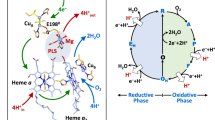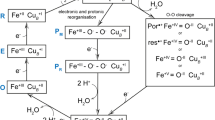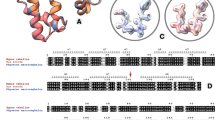Abstract
Submillisecond folding of cytochrome c reveals that a nascent phase appears within the mixing dead time of 100 μs, followed by a ligand exchange reaction during which His 26/33, water and Met 80 are inter-exchanged as haem ligands through a thermodynamically controlled equilibrium. In the ligand exchange phase, the rate of formation of a misfolded histidine-histidine coordinated state (HH) decreases by two orders of magnitude as the pH is reduced from 5.9 to 4.5 due to the protonation of the misligated His 26/33. The activation energy barriers for the transitions from the histidine-water coordinated form (HW) to the histidine-methionine coordinated form and the HH form are 18 and 4 kcal mol−1 respectively, at pH 4.8. The activation energy barrier for protein to escape from the misligated HH to the HW form was measured to be 12 kcal mol−1, demonstrating the kinetic trapping effect of the misligated bis-histidine form. The development of the polypeptide tertiary structure near the haem is concomitant with the coordination of the native haem axial ligand.
This is a preview of subscription content, access via your institution
Access options
Subscribe to this journal
Receive 12 print issues and online access
$189.00 per year
only $15.75 per issue
Buy this article
- Purchase on Springer Link
- Instant access to full article PDF
Prices may be subject to local taxes which are calculated during checkout
Similar content being viewed by others
References
Zwanzig, R., Szabo, A. & Bagchi, B. Levinthal's paradox. Proc. Acad. Sci. USA 89, 20–22 (1992).
Nail, B.T. in Protein Folding Deciphering the Second Half of the Genetic Code (Eds Gierasch, L. M. & King, J.) 198–207 (American Association for the Advancement of Science, Washington, DC, 1990).
Gilbert, H.F. in Mechanisms of Protein Folding (ed R.H. Pain) 104–136 (Oxford University Press, New York, 1994).
Elove, G.A., Bhuyan, A.K. & Roder, H. Kinetic mechanism of cytochrome c folding: involvement of the haem and its ligands. Biochemistry 33, 6925–6935 (1994).
Sosnick, T.R., Mayne, L., Hiller, R. & Englander, S.W. The barriers in proteinfolding. Nature Struct. Biol. 1, 149–156 (1994).
Takahashi, S. et al. Folding of cytochrome c initiated by submillisecond mixing. Nature Struct. Biol. 4, 44–50 (1997).
Creighton, T.E. Conformational restrictions on the pathway of folding and unfolding of the pancreatic trypsin inhibitor. J. Mol. Biol. 113, 275–293 (1977).
Weissman, J.S. & Kim, P.S. Reexamination of the folding of BPTI: predominance of native intermediates. Science 253, 1386–1393 (1991).
Sosnick, T.R., Mayne, L. & Englander, S.W. Molecular collapse: the rate–limiting step in two–state cytochrome c folding. Proteins Struct. Func. Genet. 24, 413–426 (1996).
Hu, S., Morris, I.K., Singh, J.P., Smith, K.M. & Spiro, T.G. Complete assignment of cytochrome c resonance Raman spectra via enzymatic reconstitution with isotopically labeled hemes. J. Am. Chem. Soc. 115, 12446–12458 (1993).
Jordan, T., Eads, J.C. & Spiro, T.G. Secondary and tertiary structure of the A-state of cytochrome c from resonance Raman spectroscopy. Protein Sci. 4, 716–728 (1995).
Chan, C.-K. et al. Submillisecond protein folding kinetics studied by ultrarapid mixing. Proc. Natl. Acad. Sci. USA, in the press.
Pascher, T., Chesick, J.P., Winkler, J.R. & Gray, H.B. Protein folding triggered by electron transfer. Science 271, 1558–1560 (1996).
Bushnell, G.W., Louie, G.V. & Brayer, G.D. High resolution three dimensional structure of horse heart cytochrome c. J. Mol. Biol. 214, 585–595 (1990).
Jennings, P.A. & Wright, P.E. Formation of a molten globule intermediate early in the kinetic folding pathway of apomyoglobin. Science 262, 892–896 (1993).
Fink, A., Calciano, L.J., Goto, Y. & Palleros, D.R. Acid denatured states of proteins. Curr. Res. Protein Chem. 3, 417–424 (1990).
Jeng, M.F. & Englander, S.W. Stable Submolecular folding units in a noncompact form of cytochrome c. J. Mol. Biol. 221, 1045–1061 (1991).
Antonini, E. & Brunori, M. Hemoglobin and Myoglobin and their Reactions with Ligands. 223 (North-Holland, Amsterdam, 1971).
Fersht, A. Enzyme Structure and Mechanism. p. 49 (Freeman, New York, 1985).
Matthews, C.R. Pathways of protein folding. Annu. Rev. Biochem. 62, 653–683 (1993).
Onuchic, J.N., Wolynes, P.G., Luthey-Schulten, Z. & Socci, N.D. Toward an outline of the topography of a realistic protein-folding funnel. Proc. Nat. Acad. Sci. USA 92, 3626–3630 (1995).
Takahashi, S., Ching, Y.-c., Wang, J. & Rousseau, D.L. Microsecond generation of oxygen-bound cytochrome c oxidase by rapid solution mixing. J. Biol. Chem. 270, 8405–8407 (1995).
Author information
Authors and Affiliations
Rights and permissions
About this article
Cite this article
Yeh, SR., Takahashi, S., Fan, B. et al. Ligand exchange during cytochrome c folding. Nat Struct Mol Biol 4, 51–56 (1997). https://doi.org/10.1038/nsb0197-51
Received:
Accepted:
Issue Date:
DOI: https://doi.org/10.1038/nsb0197-51
This article is cited by
-
Relating the multi-functionality of cytochrome c to membrane binding and structural conversion
Biophysical Reviews (2018)
-
The role of key residues in structure, function, and stability of cytochrome-c
Cellular and Molecular Life Sciences (2014)
-
Interaction of dimeric horse cytochrome c with cyanide ion
JBIC Journal of Biological Inorganic Chemistry (2013)
-
Structural and kinetic studies of imidazole binding to two members of the cytochrome c 6 family reveal an important role for a conserved heme pocket residue
JBIC Journal of Biological Inorganic Chemistry (2011)
-
Characterization of N-terminal amino group–heme ligation emerging upon guanidine hydrochloric acid induced unfolding of Hydrogenobacter thermophilus ferricytochrome c 552
JBIC Journal of Biological Inorganic Chemistry (2007)



